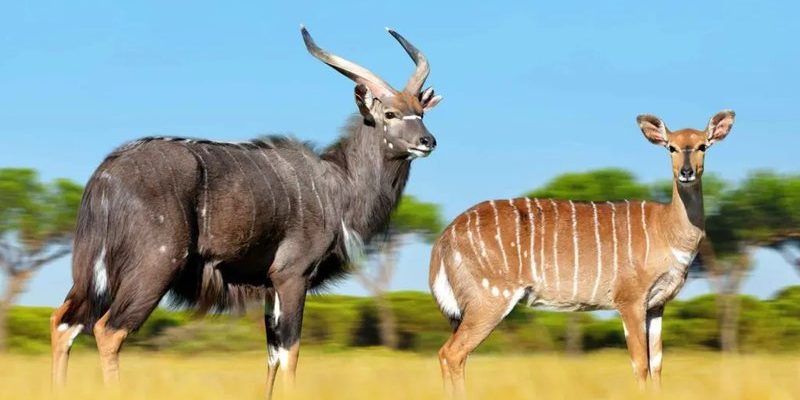![Comparing The Nyala Vs. [Similar Species]](https://gudri.com/wp-content/uploads/2025/06/Comparing_The_Nyala_Vs___Similar_Species__image_0.jpg)
Imagine you’re walking through a serene African savannah, and you spot a Nyala gracefully moving through the brush. With its striking spiraled horns and rich brown fur, it’s hard not to be captivated. Now, picture a Kudu nearby, proudly displaying its tall, twisted horns and beautiful stripes. Both creatures are remarkable in their own right, but how do they really stack up against one another? Let’s break down their habitats, physical traits, behaviors, and more.
What Are Nyala and Kudu?
The Nyala (Tragelaphus angasii) is a medium-sized antelope native to southern Africa. Males are larger than females, boasting impressive spiraled horns that can reach up to 36 inches long. Their coat features a blend of brown and white, with males often having darker fur.
On the other hand, the Kudu (Tragelaphus strepsiceros) is a larger antelope found in eastern and southern Africa. Males can weigh over 500 pounds and have some of the longest horns among antelopes. Their distinctive grayish-brown coat, adorned with white stripes, makes them particularly striking.
Both species belong to the same genus but differ significantly in size, coloration, and habitat preferences.
Physical Characteristics: Spotting the Differences
One of the first things to notice is the physical size of these two antelopes. The Nyala is smaller, with males averaging 90 pounds and females lighter, around 50 pounds. Their fur is typically a rich chestnut color, with females displaying more white markings.
The Kudu, however, is more robust and can weigh over 400 pounds. Their long, twisted horns, which can measure up to 72 inches, are distinct and serve as a hallmark of their species. Additionally, the Kudu’s grayish coat with white stripes helps it blend into its surroundings, providing excellent camouflage against predators.
If you’re lucky enough to see both animals in the wild, pay attention to their horns—it’s a quick way to tell them apart!
Behavior and Social Structure
Both Nyala and Kudu exhibit fascinating social structures. The Nyala tends to live in smaller groups, often composed of one male and several females. This arrangement helps them mate and raise their young in a secure environment. The males can be quite territorial, using their unique horns to establish dominance during mating seasons.
Kudu, on the other hand, often form larger herds, particularly females and young males. Adult males tend to be solitary, only joining the herd during breeding season. Their social interactions can be quite complex, involving vocalizations and body language. Honestly, watching these animals interact can be as entertaining as a nature documentary.
Habitat: Where Do They Live?
When it comes to habitats, both species prefer different environments. Nyala thrive in dense bush and woodlands, mainly in southern and southeastern Africa. Their preference for thicker vegetation offers them protection from predators, allowing them to navigate through underbrush with ease.
The Kudu, however, enjoys open woodlands and savannahs. You’ll often find them in less dense shrubland where they can graze on grasses and leaves. They are adaptable creatures and can be spotted in various environments, from mountainous areas to plains.
Understanding where these animals live can enhance your appreciation for them and give you insight into their survival strategies.
Diet: What Do They Eat?
Both Nyala and Kudu are herbivores, but their diets differ slightly due to their habitats. Nyala prefer browsing on leaves, fruits, and shrubs. They are known to be selective eaters, often focusing on high-protein plants, which is crucial for their growth and reproduction.
Kudu, being slightly larger, have a more varied diet. They consume a mix of leaves, fruits, and tender shoots. Interestingly, they can reach high branches with their long necks and are known for their ability to strip leaves from trees. This adaptability helps them thrive even when food sources vary.
Understanding their diets not only showcases their unique adaptations but also highlights the delicate balance of their ecosystems.
Conservation Status: Protecting These Majestic Creatures
While both species are not currently endangered, they face challenges from habitat loss and hunting. Nyala populations are stable due to conservation efforts, especially in protected areas. However, as human activities encroach on their habitats, their numbers are still at risk.
Kudu populations are also stable in many regions but can decline in areas where hunting is prevalent. Conservation programs aim to maintain healthy populations of both the Nyala and Kudu, emphasizing the importance of their roles in the ecosystem.
As wildlife enthusiasts, it’s essential to support conservation efforts to ensure these majestic animals continue to roam freely in Africa.
In comparing the Nyala and Kudu, we see two incredible species that highlight the beauty of the animal kingdom. Each has its own characteristics, habits, and habitats, making them fascinating subjects of study. Whether you’re a seasoned wildlife observer or just starting to explore the wonders of nature, understanding these antelopes enriches your appreciation for the diversity of life on our planet.
So next time you’re reading about African wildlife or even planning a safari, remember the Nyala and Kudu. Their differences remind us of the richness of the natural world and the importance of protecting it for future generations.

